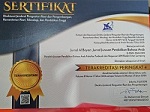Penerapan Model Pembelajaran Bahasa Arab Berbasis SAVI (Somatis, Auditori, Visual, Intelektual) dalam Meningkatkan Hasil Belajar pada Peserta Didik
Abstract
Abstract: This research is focused on to cope with the problems commonly encountered by students in learning Arabic including low retention, low motivation, lack of skills and unsatisfactory learning achievement due to insufficient learning facilities and variations. This study is aimed at acquiring obtaining empirical data "The influence of Arabic language-based learning model SAVI (somatic visual auditory intellectual) in improving the learning outcomes of students of class VIII in MTs Negeri 2 Bandar Lampung in 2016/2017". This study is a quasi-experimental research (quasi experimental research). Based on the analysis of homogeneity is known that both data result of learning the Arabic language learners class VIII G (experimental class) and the result of learning the Arabic language learners class VIII F (control group) have the same variance (homogeneous). So as to test the hypothesis can be used t-test. The calculation result obtained using t-test, t-test = 4.698 and of the distribution table at significant level known ttabel = 2.00 therefore thit> ttable.The results of these calculations at the same time also shows that the application of the model of learning Arabic based SAVI can significantly affect the learning outcome Arabic language learners because learning model Arabic-based SAVI can make students more creative, independent, more active and feel unfettered in the learning process in the classroom.
Keywords: Arabic, Learning, Models, SAVI
Full Text:
PDFReferences
Tara L. Amann, Fifth International Conference On Transformative Learning Transfor-mative Learning In Action: Building Bridges Across Contexts And Disciplines (New York: Teachers College Columbia University 525 West 120th St, 2003), h.27, Law Reviews, https://meridian-university.edu/images/tlc/ roceedings/ TLC Proceeding 2003.pdf (diakses 8 Agustus 2015).
Asrori, Imam. (2011). Strategi Belajar Bahasa Arab Teori dan Praktik. Malang: Miskat Indonesia.
Briggs, Leslie J. (1979). Instructional Design: Principles and Aplications. New Jersy: Educational Technology Publication, Inc., Englewood Cliffs.
Choi, Hee Jun and Scott D. Johnson. (2015). “The Effect of Context-Based Video Instruction on Learning and Motivation in Online Courses”, The American Journal Of Distance Education, Vol.19 No.4, h. 215, Law Reviews,https://pdfs.Semanticscholar. org/291a/db034f78a60ed219e13a3d8144086a1417fc.pdf (diakses 29 Desember 2016).
DePorter, Bobbi. (1992). Quantum Learning: Unleashing the Genius in You. New York: Bantam Doubleday Dell Publishing Group.
Fachrurrozi, Aziz dan Erta Mahyudin. (2010). Pembelajaran Bahasa Asing, Metode Tradisional dan kontemporer. Jakarta: Bania Publishing.
Gagne, Robert M and Leslie J. Briggs. (1979). Principles of Instructional Design.New York: Holt, Rinehart and Winston.
Gilakjani, Abbas Pourhossein. (2015). “Visual, Auditory, Kinaesthetic Learning Styles and Their Impacts on English Language Teaching”. Journal of Studies in Education, Lahijan, Iran: Islamic Azad University, vol.1, No.2, Law Reviews, http://dx.doi.org/ 10.5296/ jse.v2i1.1007 (diakses 08 Agustus 2016).
Gustafson, Kent L. and Robert Maribe Branch. (2002). Survey of lnstructional Development Models, Third Edition. New York: Eric Clearinghouse on lnformation & Technology Syracouse University.
Iskandar, Dadang et al. (2016). “Implemetation Of Model Savi (Somatic, Audiotory, Visualization, Intellectual) To Increase Critical Thinking Ability In Class IV Of Social Science Learning On Social Issues In The Local Environment”. Journal of Education, Teaching and Learning Vol.1, No. 1. Law Review. http://journal.Stkipsingka wang.ac.id /index.php/JETL/article/.../16 (diakses 29 Desember 2017).
Koderi dan Rukimin (2015), Multimedia Interaktif dalam Pembelajaran Bahasa Arab, Prosiding Workshop Nasional Pascasarjana Program Studi Teknologi Pendidikan Universitas Sebelas Maret, Solo: 28 November 2015.
Jado, Saleh Mohammad Abu. (2015). “The Level Of Multiple Intelligences In Arabic Language Textbooks For Grades From (1 - 4) In Jordan In Light Of Gardner’s Theory. Creative Education,, 6, 1558-1572, Published Online August 2015 In Scires. http://Www.Scirp.Org/ Journal/Ce , http://Dx.Doi.Org/10.4236/ Ce.2015.614156, (diakses 29 Desember 2016).
Joyce, Bruce., Marsha Weil, and Emily Calhoun.(2009). Models of Teaching Eigth Edition. New York: Pearson.
Kim, Kyong-Jee and Theodore W. Frick.(2011).“Changes In Student Motivation During Online Learning”, Journal Educational Computing Research, Vol. 44, No.1. Law Reviews, http://journals.sagepub.com /doi/abs/ 10.2190/EC.44.1.a (diakses 29 Desember 2016).
Meier, Dave. (2000). The Accelerated Learning Handbook A Creative Guide to Designing and Delivering Faster, More Effective Training Programs. New York; McGraw-Hill San Francisco Washington, D.C.
Reigeluth, Charles M. (2009). Instructional Design Theories and Models an Overview of Their Current Status. New Jersey: Lawrence Erlbaum Associates, Publisher.
Smaldino, E. S., D.L Lowther and J. D. Russell. (2008). Instructional Technology and Media for Learning, Upper Saddle River, New Jersey: Prince Hall.
Suparman, M. Atwi et al. (2013). “Guru Sebagai Arsitek Pembelajaran Sepanjang Waktu: Mungkin?”, Prosiding Seminar Universitas Terbuka. Jakarta: 02 Desember 2013
Zhang, Dongsong et al. (2016). “Instructional video in e-learning: Assessing the impact of interactive video on learning effectiveness”. Journal Information & Management, Vol 43. Law reviews, https://pdfs. Semanticscholar.org/ 4f6e/a57d ddeb 2950feedd39101c7bd586774599a.pdf (diakses 29 Desember 2017).
DOI: http://dx.doi.org/10.24042/albayan.v10i01.2596
Refbacks
- There are currently no refbacks.
Copyright (c) 2018 Koderi Koderi
Editorial Office:
Jurnal Al Bayan: Jurnal Jurusan Pendidikan Bahasa Arab, Arabic Education Study Program, Faculty of Education and Teachers Training, Unversitas Islam Negeri Raden Intan Lampung
Jl. Endro Suratmin 1 Sukarame, Bandar Lampung 35131-Indonesia
e-mail: jurnalalbayan@radenintan.ac.id
http://ejournal.radenintan.ac.id/index.php/albayan/index
Jurnal Al Bayan: Jurnal Jurusan Pendidikan Bahasa Arab is licensed under a Creative Commons Attribution-ShareAlike 4.0 International License. p-ISSN 2086-9282 | e-ISSN 2549-1229









